If you have a small garden, you know how physically draining and mentally challenging it can be to accommodate different types of fruits and plants in one piece of land.
Some plants grow in pots while a few others that are smaller can share the same space in large containers.
As for medium to large-sized fruit trees that can only grow on the ground, they will take up most of the space in your garden. Since most horizontal spaces are likely occupied, you might investigate fruiting vines that climb on vertical structures.
In this article, we have listed 13 types of fruit-bearing vines that you can grow at home.
Table of Contents
1. Grapes (Vitis vinifera)

Grapes are the fruits that drive the wine industry. They are native to Asia and the Middle East.
These small, round fruits come in different species with different skin colors such as dark blue, green, yellow, black, pink, and orange. They grow in small to large clusters. Each cluster may consist of 15 to 300 fruits.
Grapes thrive in hardiness zones 4 to 10. They grow best in an open space with at least 7 to 8 hours of exposure to full sun daily.
These fruits only need simple vertical structures to cling to such as arbors and trellises. If you have limited space to build additional structures, you can also train them to grow on fences and walls.
2. Passion Fruit (Passiflora edulis)
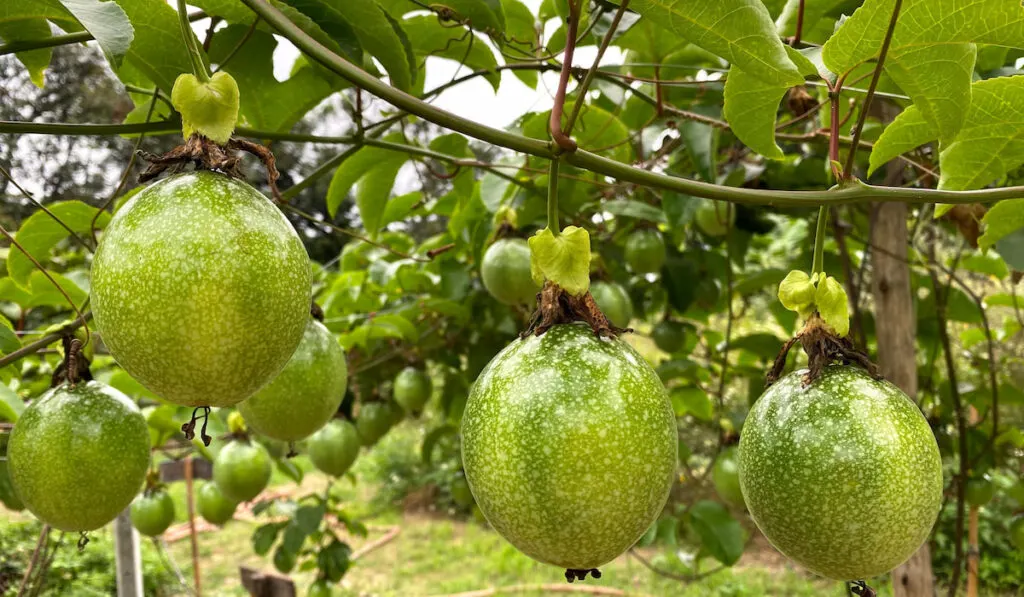
Passion fruits are indigenous to Brazil. They are also widely cultivated in tropical and warm regions such as Asia, Africa, and South America.
These tropical fruits are available in two colors, dark purple and yellow. Yellow passion fruits are much larger than their counterparts.
The vines are active climbers that grow best in sunny and warm places.
It takes between 18 months to 2 years for passion fruit vines to produce flowers and fruits.
Passion fruits are also rich in different nutrients including carbohydrates, protein, sodium, vitamin C, sugars, fiber, and calories. You can consume these fruits raw or slice them and keep them refrigerated.
3. Bitter Melon (Momordica charantia)
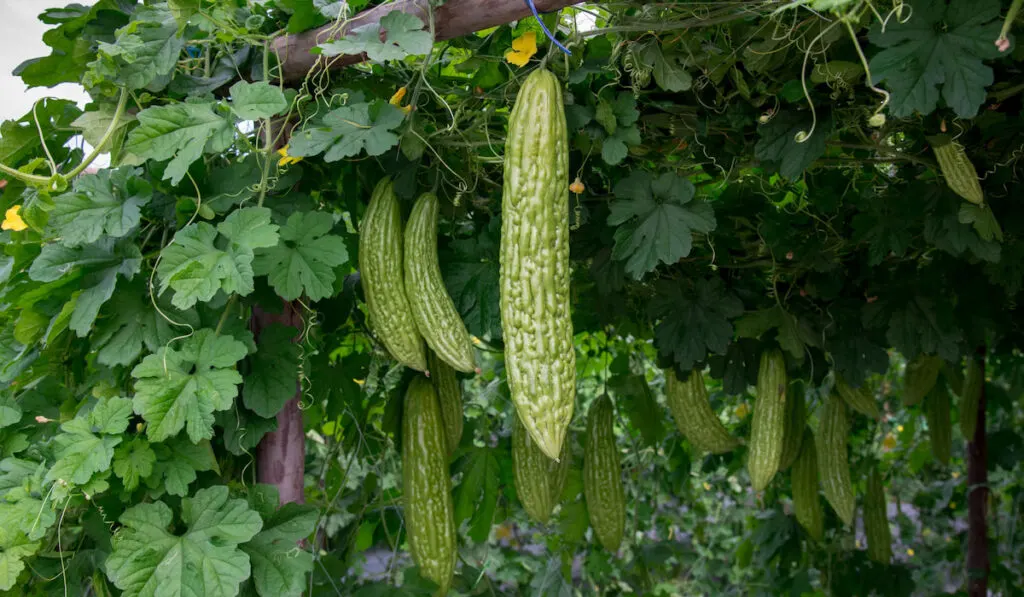
Bitter melons hail from Africa. They are also known as bitter gourd, bitter squash, Koya, Garela, and balsam pear.
These fruits are popularly used in Asian cuisines. They come in two different cultivars, which are Indian and Chinese bitter melons.
Indian bitter melons possess dark to pale green skins. They also have prominent, deeply ridged skins and pointy ends.
Meanwhile, Chinese bitter melons have smoother, less prominent ridges with pale green skins and rounded ends.
Both varieties are excellent climbers that grow well on trellises, poles, and other vertical structures.
Bitter melons thrive in hardiness zones 9 to 11. They prefer slightly acidic, well-drained soils and areas with enough exposure to full sun.
4. Blackberry (Rubus subg. Rubus)
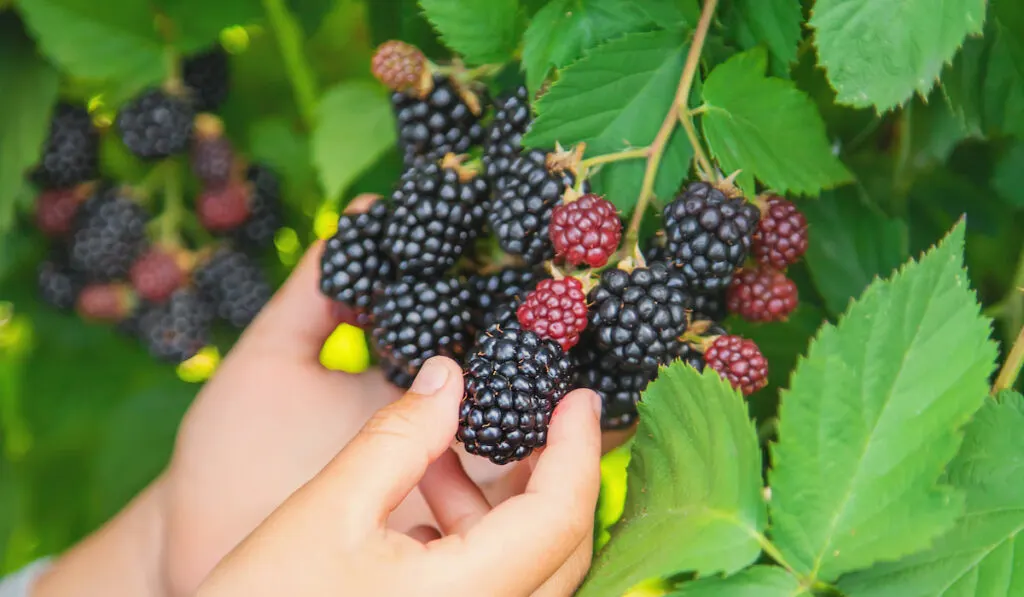
Blackberries are native to many parts of the world including Europe, Asia, and North and South America.
These drupes possess deep purple smooth skin with soft and juicy flesh. Their flesh tastes sweet, earthy, and tart-like.
There are three major varieties of blackberries which are erect thorny, erect thornless, and erect trailing blackberries.
Both erect thorny and thornless blackberries grow upright on their own. Meanwhile, erect trailing blackberries can only grow on vertical structures such as trellises or arbors.
Blackberries thrive in hardiness zones 4 to 10. They grow best in acidic soil and open areas that receive unfiltered sunlight.
When growing these fruits, be sure to water them frequently.
You can also mulch the soil, which helps in retaining moisture while preventing weeds from growing around the plants.
5. Cantaloupe (Cucumis var. melo cantalupensis)

Cantaloupes are native to regions around South Asia and Africa. They are known by different names in different countries such as spanspek in Southern Africa and sweet melon in Australia.
On average, these medium-sized, round melons weigh 1 to 11 pounds.
There are two types of cantaloupes that you can find—European and North American cantaloupes.
North American cantaloupes possess ribbed and coarse light green skins with sweet orange flesh. Meanwhile, European cantaloupes have spotted grayish-green skins with sweet interiors.
Since these fruits can grow bigger and weigh more than other climbing fruits, they need strong and sturdy structures to grow vertically.
Still, you can train them to grow on trellises, fences, thick poles, and other homemade structures.
6. Strawberry (Fragaria x ananassa)
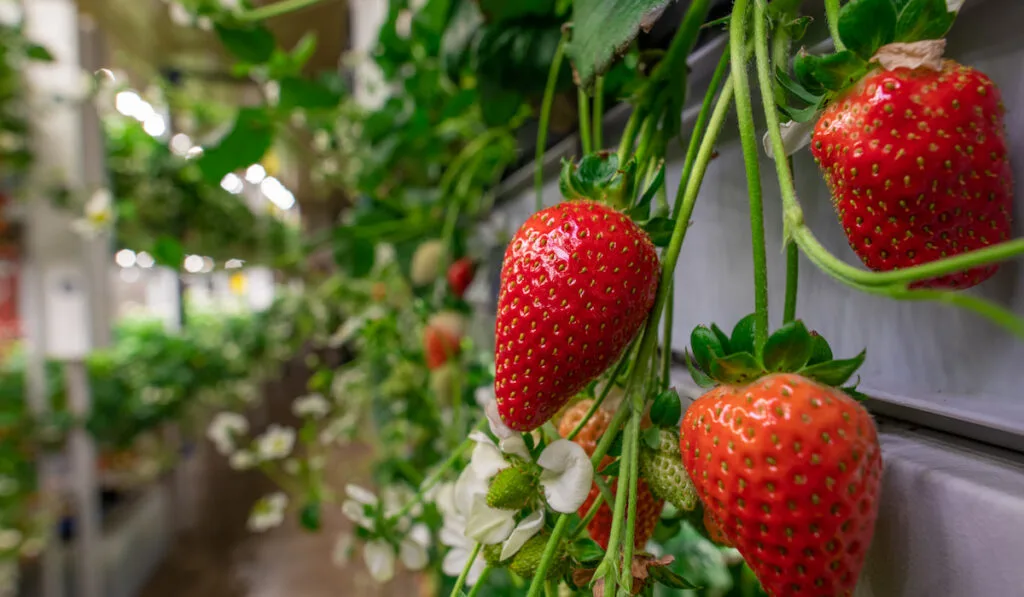
Although many farmers grow strawberries in pots, containers, and garden beds, it is not impossible for you to train these fruits to climb and grow vertically.
However, not all strawberry varieties are considered good climbers.
Strawberries that excel at climbing should have long runners that allow them to climb higher on vertical structures.
Some of the varieties that you can train as climbers are ‘Skyline,’ ‘Mount Everest,’ ‘Mara de Bois,’ and ‘Rambling Cascade.’ All of these strawberries have runners that can grow 5 to 6 feet long.
Since strawberries aren’t natural climbers, you need to be patient when training them to grow on trellises, poles, arbors, and other vertical structures.
Be sure to monitor the growth of the runners and always adjust their position when they start to grow higher and longer.
7. Tomato (Solanum lycopersicum)
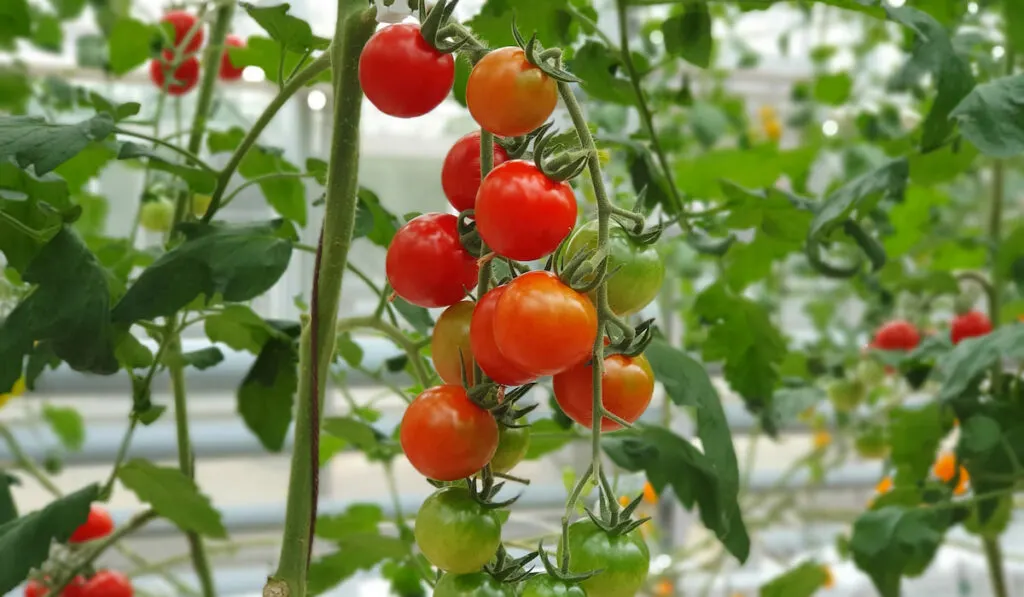
Tomatoes are native to South America. They are also widely cultivated in other countries such as China, India, Egypt, Turkey, and the United States.
These fruits come in different sizes, shapes, and forms. Depending on each variety, tomatoes may have different skin colors including red, yellow, pink, orange, and bicolors.
There are two categories of tomatoes that you can grow which are determinate and indeterminate.
Determinate tomatoes grow and yield fruits for only a short period of time, whereas indeterminate tomatoes are vines that grow throughout many seasons until they eventually die.
You can grow both types in your garden. However, indeterminate tomatoes can grow longer and higher than determinate tomatoes.
So, you will need taller trellises or vertical structures to accommodate their growth.
8. Chocolate Vine (Akebia quinata)

Chocolate vines are native to Asia, specifically in Japan, Korea, and China. They are also called five-leaf chocolate vines and five-leaf akebias.
You can recognize these plants by their dark green, oval-shaped compound leaves, purple to brown tri-petaled flowers, and light purple oblong to oval-shaped edible fruits. Their flowers also produce chocolate-like scents.
These vines grow up to 30 feet tall and spread 1 to 2 feet wide. They thrive in hardiness zones 4 to 8 and are capable of tolerating partial or full sun.
Although chocolate vines don’t cling to vertical structures like most climbing plants, you can still train them to grow vertically.
Be sure that they grow on strong and stable trellis, fences, or poles.
You should also tie their stems closely, but not too tight, to the structures to prevent the plants from slipping off or falling when the weather is harsh.
9. Dragon Fruit (Hylocereus undatus)
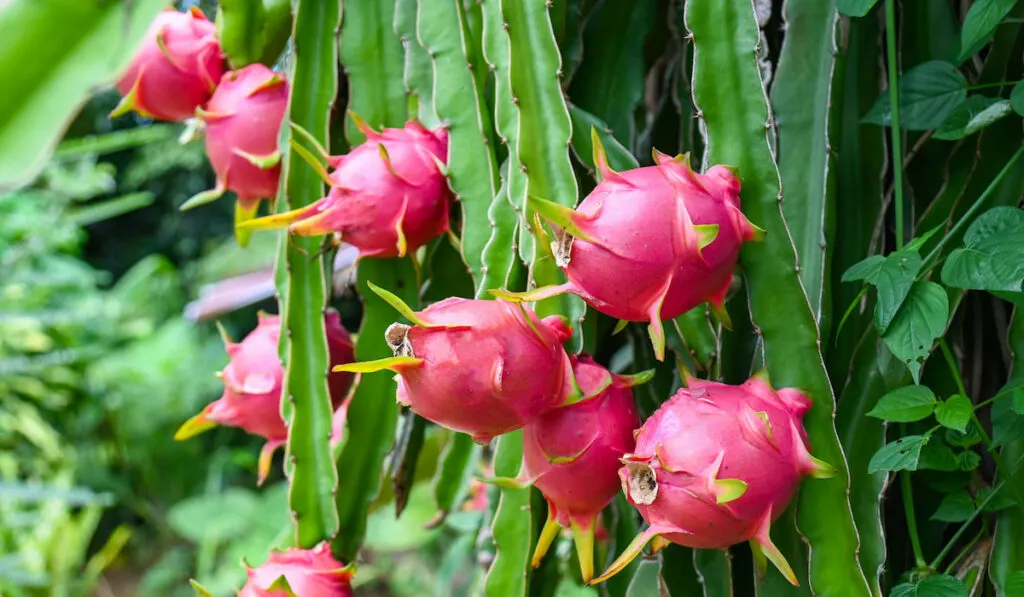
These exotic tropical fruits originated in Central America. They are also grown in other parts of the world including Australia, Israel, China, and South East countries.
Depending on where you live, you might’ve heard people call dragon fruits by many other names such as strawberry pear, dragon pearl fruit, and pitahaya.
You can spot dragon fruits by their bright pink skins covered with tender, green spikes, and sweet, white interiors.
The plants also produce large, fragrant, and bell-shaped white flowers that only bloom at night.
Since dragon fruit plants have thick, long, and heavy spiky green leaves, you will need to grow them on sturdy vertical structures that are made from materials such as steel or wood.
The plants can also grow up to 20 feet tall. So, be sure to build a stable trellis with a sturdy base that won’t topple easily.
10. Kiwi (Actinidia deliciosa)
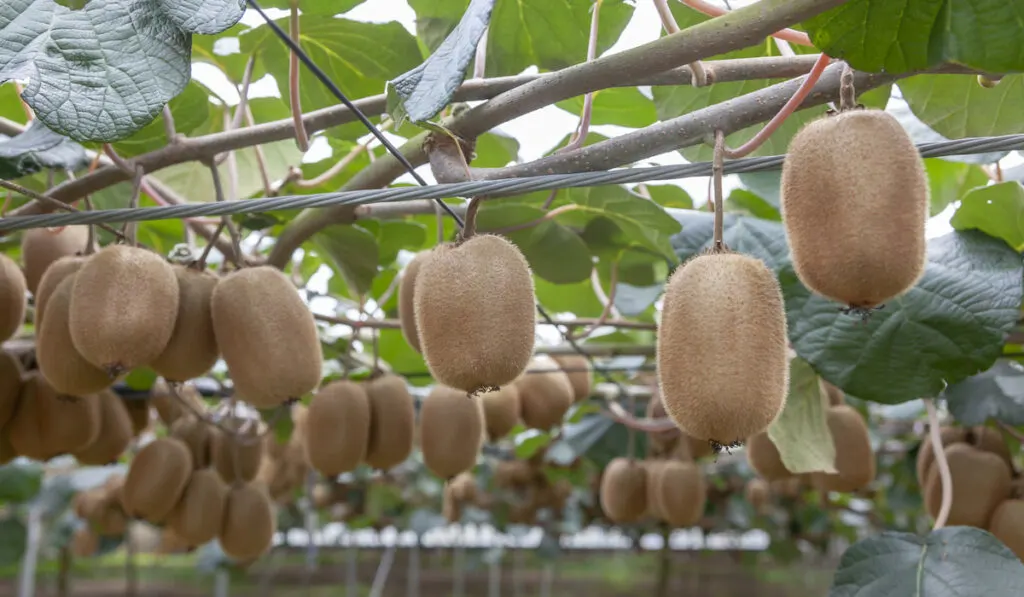
Kiwis, or Chinese gooseberries, are native to central and Eastern China. Back in the old days, these fruits grew freely in the wild before they were brought to and commercially grown in New Zealand.
Kiwi fruit started to gain popularity in other places after World War II, when American and British Armies who served in New Zealand began to take interest in these unique fruits.
There are two types of kiwis which are kiwifruits and kiwi berries.
Kiwifruits possess fuzzy, hairy brown skins with sweet, light green flesh and hard kernels. Meanwhile, kiwi berries have smooth green skin with the same flavor and flesh texture.
These two varieties also thrive in different hardiness zones. For instance, kiwi berries perform well in hardiness zones 4 to 7, whereas kiwifruits grow best in hardiness zones 8 to 9.
But they both prefer well-drained soil and areas with enough exposure to full sun.
Kiwis are considered slow-growers. The plants only start to produce fruits after 3 to 5 years of planting.
11. Gooseberry (Ribes spp.)

Gooseberries are categorized into two major species which are European and American gooseberries.
European gooseberries are native to North Africa, whereas American gooseberries originated from Canada and the United States.
These plants possess thorny stems, dark green leaves, tiny whitish-cream flowers, and small, round fruits that come in different colors ranging from red to green and yellow. They grow 3 to 10 feet tall and spread to 6 feet wide.
Gooseberries are flexible climbers that can grow on many types of vertical structures. You can train them to grow on trellises, fences, walls, and other structures.
Moreover, they don’t take up a large growing space. As long as they receive enough sun, water, and other essential nutrients, they can even fit in narrow spaces and crowded areas.
12. Honeydew Melon (Cucumis melon var. inodorus)
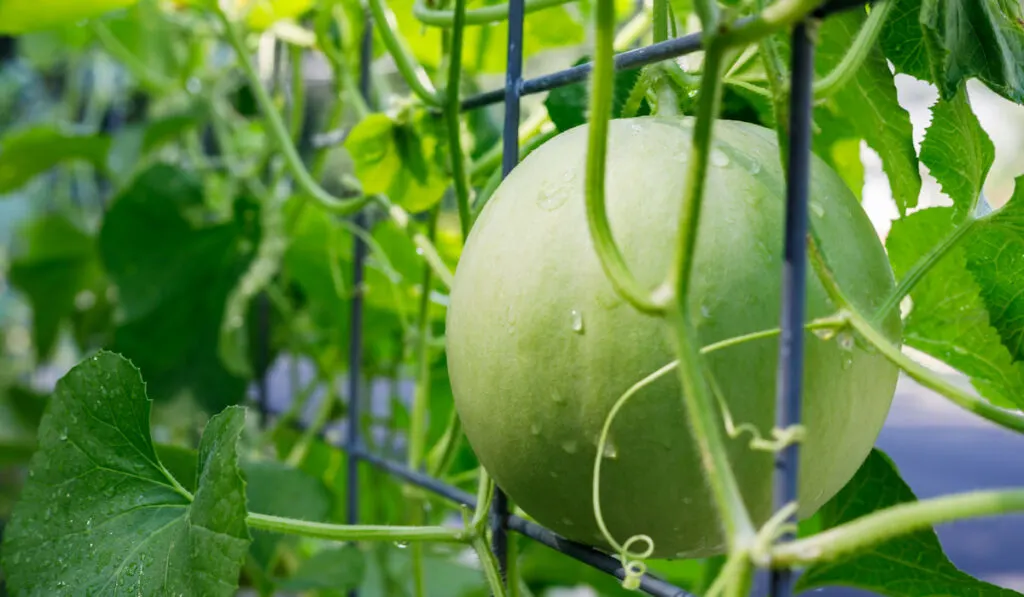
Honeydew melons are indigenous to West Asia, West Africa, and the Middle East. They are available in two types, which are orange and white honeydews.
Depending on the varieties, these fruits may possess different skin colors including white, green, yellow, and light orange.
Their sweet interiors also come in different colors such as whitish-green, golden orange, and light green.
On average, honeydew melons measure 6 to 9 inches wide and weigh 4 to 8 pounds. They are also rich in vitamins C, K, and B6, magnesium, potassium, folate, fiber, and other nutrients.
These fruits grow best in well-drained soils and regions with long exposure to full sun.
Since honeydew melons become heavier when they mature, you should grow them on sturdy trellises or mounds that can withstand their weight.
13. Mouse Melon (Melothria scabra)

This miniature version of watermelon hails from Mexico and Central America. They are also called cucamelons, Mexican sour gherkins, and Mexican sour cucumbers.
Mouse melons possess smooth light green skins filled with dark green stripes and spots similar to watermelon skins.
The plants also have hairy stems, palmate leaves, curled tendrils, and small, five-petaled yellow flowers.
Mouse melons have juicy interiors that taste like cucumbers.
It usually takes between 70 to 75 days for these fruits to mature.
Mouse melons prefer well-drained soil and areas with enough exposure to full sun. These climbing vines can also grow up to 10 feet tall on any sturdy vertical structures.
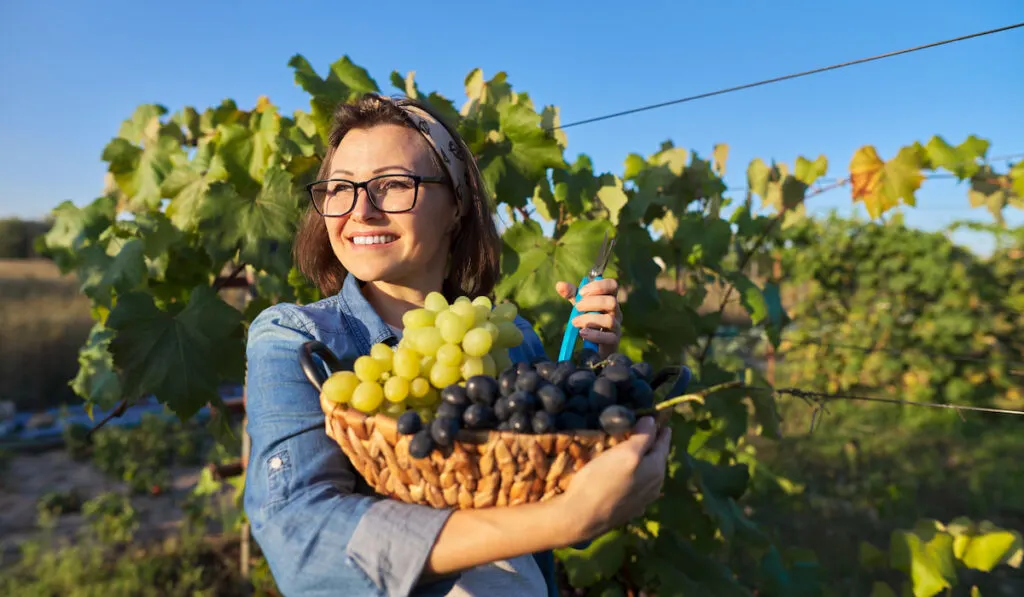
What Is the Easiest Vine Fruit to Grow?
Out of the 13 vine fruits we have listed above, grapes are the easiest to grow. This is because they have a wide range of hardiness zones, which cover many parts of the United States.
No matter where you live, there is always an opportunity for these fruits to grow. Moreover, you can train grapes to grow in narrow spaces without having to build a specific structure exclusively for them.
Last but not least, these fruits are compact and they won’t take up a large space in any given area.
Final Thoughts
No matter which types of climbing fruits you choose to grow, the structure they cling to should always be strong and sturdy.
Medium-sized and heavy fruits such as cantaloupes and honeydew lemons are best grown on stable structures like arbors and trellises.
Meanwhile, berries and grapes that grow in clusters are safe to climb and cling onto supporting wires, obelisks, and other lightweight, homemade structures.
But if you live in windy regions, both light and heavy structures will need additional supporting structures to make them sturdier and less wobbly.
Resources
- https://en.wikipedia.org/wiki/Grape
- https://www.monrovia.com/be-inspired/5-easy-steps-for-growing-grapes.html
- https://discovered.nl/en/products/passion-fruit/
- https://www.masterclass.com/articles/how-to-grow-passionfruit
- http://heritagegarden.uic.edu/bitter-melon
- https://en.wikipedia.org/wiki/Momordica_charantia
- https://specialtyproduce.com/produce/Blackberries_102.php
- https://www.almanac.com/plant/blackberries
- https://en.wikipedia.org/wiki/Cantaloupe
- https://gardenerspath.com/plants/fruit/trellis-cantaloupe/
- https://plantura.garden/uk/fruits/strawberries/climbing-strawberry-plants
- https://www.bionity.com/en/encyclopedia/Tomato.html
- https://www.allaboutgardening.com/trellis-tomatoes/
- https://en.wikipedia.org/wiki/Akebia_quinata
- https://www.thespruce.com/grow-chocolate-vine-1316033
- https://eresources.nlb.gov.sg/infopedia/articles/SIP_768_2005-01-11.html
- https://planthouseaesthetic.com/how-to-make-an-affordable-durable-trellis-for-dragon-fruit-plants/
- https://en.wikipedia.org/wiki/Kiwifruit
- https://www.almanac.com/plant/kiwifruit
- https://plantvillage.psu.edu/topics/gooseberry/infos
- https://www.rhs.org.uk/fruit/gooseberries/grow-your-own
- https://www.specialtyproduce.com/produce/Honeydew_Melon_1705.php
- https://bonnieplants.com/blogs/how-to-grow/growing-cantaloupe-and-honeydew-melons
- https://hort.extension.wisc.edu/articles/mouse-melon-or-mexican-sour-cucumber-melothria-scabra/
- https://dengarden.com/gardening/How-to-Grow-Mouse-Melons
